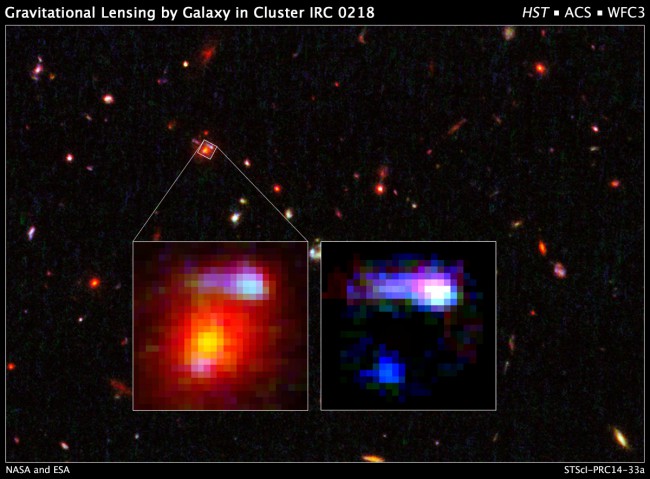Astronomers using NASA’s Hubble Space Telescope have unexpectedly discovered the most distant galaxy that acts as a cosmic magnifying glass. Seen here as it looked 9.6 billion years ago, this monster elliptical galaxy breaks the previous record-holder by 200 million years.
These “lensing” galaxies are so massive that their gravity bends, magnifies, and distorts light from objects behind it, a phenomenon called gravitational lensing. Finding one in such a small area of the sky is so rare that you would normally have to survey a region hundreds of times larger to find just one.
The object behind the cosmic lens is a tiny spiral galaxy undergoing a rapid burst of star formation. Its light has taken 10.7 billion years to arrive here and seeing this chance alignment at such a great distance from Earth is a rare find. Locating more of these distant lensing galaxies will offer insight into how young galaxies in the early universe build themselves up into the massive dark-matter-dominated galaxies of today. Dark matter cannot be seen, but it accounts for the bulk of the universe’s matter.
“When you look more than 9 billion years ago in the early universe, you don’t expect to find this type of galaxy lensing at all,” explained lead researcher Kim-Vy Tran of Texas A&M University in College Station. “It’s very difficult to see an alignment between two galaxies in the early universe. Imagine holding a magnifying glass close to you and then moving it much farther away. When you look through a magnifying glass held at arm’s length, the chances that you will see an enlarged object are high. But if you move the magnifying glass across the room, your chances of seeing the magnifying glass nearly perfectly aligned with another object beyond it diminishes.”
For images and more information about Hubble, visit: http://www.nasa.gov/hubble
For the full article click here: http://hubblesite.org/news/2014/33

